American vs European – which type is better?
Translation: Galina Soroka
This article is about the differences between American Doberman pinscher and European Dobermans. I think that the comparison to obtain an objective and impartial, although, of course, expresses my personal opinion. Written several years ago, this article is still relevant. It was published in the journals of the Dobermann in many countries.
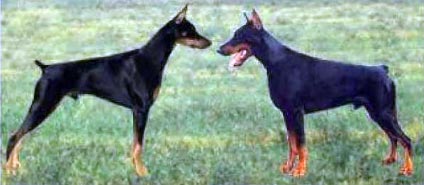
We are the best! Any American will tell you that “of course, the American doberman- Pinscher the best in the world!”. Since we are – self-confident and have no doubt that the best of our Dobermans in the world and can not be. Or still can? Of course, we have seen how the South Americans and Canadians were we compete on our own site. But they are all descended from American dog, and just like them, and not on these “second-class European Dobermans.” On the other hand, few Europeans is serious about American breeding Dobermanns. This approach is just hinders the development of our beloved breed. For Europeans, our doberman- Pinschers – spineless namby-pamby, but for Americans, European Dobermans – brute and aggressors. Some even believe that the gap between European and American Dobermans are so large that they must be split into two separate species. Of course, the two characteristics – it is much exaggerated generalizations. As an illustration, I have included in the article examples of European Dobermans and American did not, just to preserve their own health and avoid the question, I do not if I mishandled Cossack.
I understand that such definitions can be endless. On the one hand we have a rough, heavy, inelegant, fat, too large, congested, very aggressive European Doberman. On the other it is too light, too small, exaggerated elegant and very timid American. Between them, these Dobermans are placed world-class. They are found everywhere, not only in the good old America. In the Best-Of-Luchshh elegance combined with good bone and substance, balanced movement with good mentality and adequate response to any situation. In this article I will try to formulate their own ideas about what is good and bad in both types. I understand that someone will convict me of error, but do not forget that I’m trying to act like a generalizing perspective.
The character/temperament – this is one of the most significant features of the differences honey to European and American Doberman Doberman pinscher. In addition, it is one of the reasons why the European experts never include American dogs in their breeding program. In most European countries in the breeding are allowed to use only those dogs that have passed ZTP test or other similar hard test. Description ZTP test can be found on the website ( http://www.dobermann-review.com ) in the sections: Articles (Articles), General (General), Rules (Rules), ZTP Regulations (ZTP Rules). This test is an enhanced and more rigorous version of the American test WAE 2 and includes checking the stability of temperament in a relaxed atmosphere, and a protective response in the attack. It has not passed the test the dog is not suitable for breeding. All point. A descendant, all whose ancestors to the seventh generation went through ZTP, probably also successfully pass the test this. Europeans do not want to take risks in the breeding and waste time and money for the American dog, whose origin does not guarantee passage of this test.
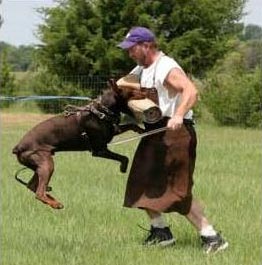

Many Americans call their Dobermans “Velcro» 3 . While in Europe, I met not a lot of Velcro-Dobermans. Not that there is not Dobermans are devoted to their owners, but they do not stick to them. Rather, they tend to jump to their owners, but do not hang them on your neck. The majority of American Dobermans are very affectionate and at times behave like a childlike couch dog, a kind of black-and-tan golden retrievers. Their European relatives like all members of his family, but they are a little more wary of all strangers. One gets the impression that they do not do anything halfway, laid out on all cylinders, whether it be a game, protection, love of family, the show in the show ring or participating in competitions. However, for my taste, some European dogs are too energetic for home detention. Sometimes they get turned in the manner of a such 40-kilogram border collie, which is not so easy to calm down. It is good for a working dog, but not very suitable for a companion dog, and most owners in the United States do not know how to handle dogs with temperament. For Europe, this is not the best option. The ideal would be a confident dog with a free and easy character, attentive to everything that is happening around and ready to respond as threatening, and the neutral situation, having sufficient intelligence to distinguish one from another.
A general view – the picture in the beginning of the article I cited does not, as an example of the best or the worst representatives of Dobermans European and American types. They are only loosely illustrate the differences between the two. Usually American Doberman more refined and elegant, like, say, ballet dancer or a striker in football. European Doberman, are usually more robust, with a much more deep chest, I would compare to a gymnast or a quarterback in college football.
Many years ago, Herman Felton 4 wrote in his article that the Doberman should be “elegant like a rhino.” Then I thought he was crazy, but over the years gaining experience, I realized that he was talking about and had to agree with him. Doberman can be strong bones, good substance, and thus it can be elegant. Elegance does not rule out the substance.
head – there is no doubt that the Europeans have paid more attention to the formation of the head than the Americans. This is the statue, which in America for many years, largely ignored, partly occurred due to the popularity of several manufacturers whose heads were noticeably inferior to the rest of their merits.
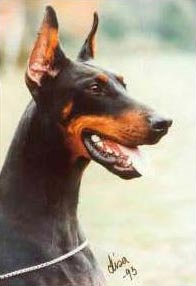
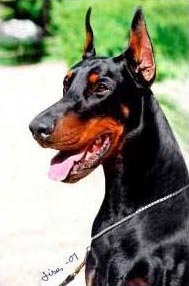
In general, the European Dobermans best line of the head, dark eyes and a better filling suborbital region. They also tightened the lower jaw and fewer problems with their teeth, as the lack of a single tooth is a serious shortcoming, and the lack of two – disqualify 5 . (The author is mistaken for standard FCI Dobermann should have all 42 teeth.)
neck – This article by the American dogs far exceeds Europe. Not many Dobermans in Europe the neck of the same length and with the same curvature as in America. Most European Dobermans neck is shorter and straighter. Their neck goes into the withers is not as beautiful as in the US, and as it were fastened to the body that have not yet “sheep neck» 6 , and soon enough a smooth transition. Many people think that elegant neck weaker, some even believe that it is associated with CVI 7 , which, in my opinion, it is unsubstantiated conjecture.
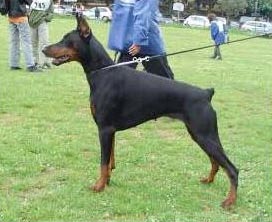
Shoulder – the American dogs are usually slightly better than the slope of the shoulder blade. At the same European counterparts usually better the slope of the shoulder. The wide, heavy, sharp shoulders tilt in America now more common than ever, and definitely more common than in Europe.
The backbone/body – in both standards, AKC 8 and FCI, is required “strong bones”. Krepkokostnye dogs are common in Europe, but on the American show – they are a rarity. On the other hand, many European Dobermans enough tucked up abdomen, which spoils the bottom line and makes stockier dogs and inelegant. Rounded grains are also more likely to occur in the European show rings, than American. Many Americans are critical of the overly inclined liniii top European dogs. Some European Dobermans actually sharper slope of the topline than the US, but often only the top looks like in the photos, but not in life, thanks to the rack in which the dog show and the personal preferences of some European breeders. Recently discussed proposals to replace the words in the American standard “straight top line” to “horizontal.” This is certainly desirable in the movement. But many of our Dobermans in the top rack level and in the movement of highly-backawn appear as if they were running down the hill. This is because in the rack front legs are under the body withers and takes the highest position. In the same movement forelimbs are carried forward and back, withers few drops, and the dog looks highly-backawn. This highly-backawn increasingly common, which allow, of course, impossible. Another noticeable difference in buildings – is the length of the waist. European dogs is usually smaller and are almost never long because of the stretched waist. Typically, the elongated body of the European Dobermans associated with the length of the chest, and the US almost always – with a length of the loin.


The hindquarters – better overall look at the American Dobermans, though, mainly because they are easier to evaluate. The European Dobermans do it harder from behind the counter, which shows them. Often the leash stretched tight as that of a dog because of her “vpryadennosti” appears “cow hocks”, which is absent in the relaxed bar. For this reason, some Dobermans, who actually has Korovin, successfully perform in the ring, which can not be in America. In this case, the majority of European Dobermans ray muscled hind limbs, especially the shins, which are always more powerful than those of their American relatives. Europeans usually less pronounced corners and shorter paw, and rarely encountered a dog with sharp corners of the hind limbs and long lower legs than in the United States.
Feet – them Europeans could pay more attention. This does not mean that European Dobermans entirely bad legs ridiculously long. But compact, with fingers pressed “cat” paw undoubtedly meet more often in American rings.
Wool and tan – I just do not understand how anyone can argue with the fact that the rich black and dark brown colors European dogs is much more beautiful. The same applies to the bright, saturated rusty-red tan, which is much more attractive than a fairly bright and even light tan, often found in dogs in the United States. Many Europeans have criticized American Dobermans for their bright and too wide tan. On the other hand, some European dogs succumbed borders are blurred, blackened and too small. But I believe that this is only an exception, the size and cleanliness of tan markings are not a problem for either one or the other types.
Traffic – I do not think that there are great differences in the two types of movement Dobermans. On both sides of the Atlantic have a dog as a good and a bad move. One gets the impression that all Americans give more attention to good movement, and rightly so. In Europe, the examination and the description of each dog includes an evaluation of its movements back and forth and side. But in the final arrangement often take into account the rack rather than movement. In many cases, the movement of European dogs is difficult to assess because of the manner of their display on the move because of the ineptitude of some handlers.
So I went to the show dogs. It is generally accepted that American handlers – the most skilled in the world. Many are of the mediocre dogs do pretty well, and put srednyachkov champions. I want to warn American readers, that looking at pictures of European Dobermans, it is understood that their stand is different from that which is considered to be correct with us. Usually they are “injected” into the rack of motion with minimal manipulation with the production of the limbs, and such jay quite natural. But still show dogs in Europe is not so, “is natural”, as claimed by many Europeans. Most trained dogs to the best European handlers can correct stance only slightly pulling back the lead, while the American dogs have to respond to the leash hanging in front of them. I also have to disagree with my friends the Europeans that, they say, the dog, the host stand for tension and leash by double Handling and bait, making it more natural than in the US show that dogs poddergivaet or lure in front. There is no doubt that the level of the show in America is higher than anywhere else in the world. I repeat – it does not mean that the handlers in other places are bad, but there is a lot more owners of their own showing their dogs, and the whole show is given not so much matter. Judges there are more paying attention to the dog than on her show, as it should be.
Unfortunately, in many European countries because of the bans on tail docking and ear to the Dobermanns lose interest. Dobermans with uncropped ears and long tails completely lose the characteristic appearance of the breed. But that’s a topic for another article.
highest class Dobermans can be found in many corners of the earth, not just in America. It is unfortunate that a large number of personal prejudice everywhere, not only in America, prevents us from seeing the wonderful virtues of dogs no matter where they were born. We all need to try to objectively assess the dogs, no matter what the border. This will help to expand the gene pool as a whole, as well as get rid of entrenched local livestock breeding drawbacks by the use of foreign dogs without similar shortcomings.
A successful breeding of all !!!
Here are some more photos:
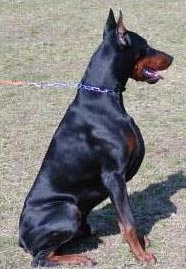
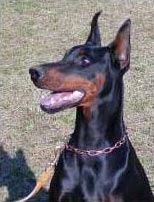

- Doug Matson, co-owner of the kennel Kansa Dobe ( http ://www.kansadobe.com/), hereinafter – approx. Perevi.
- Working Aptitude Evaluation (WAE) – assessment of the ability to work, http://dpca.org/awards/wae/index.php
- Velcro – Velcro fastener, in the jargon of the Amer. Kennel mean – a dog that wants to continually be close to the host
- Herman and Judith Felton, in 1995. In the annual nomination of the American Doberman Pinscher Club was chosen honored members of the club, has devoted much of his life to this breed
- In fact, according to FCI standard Doberman disqualified even in the absence of one tooth
- In the Russian cynological terminology “deer neck»
- Cervical Vertebral Instability (Wobbler), common in Dobermans hereditary disease of the cervical spine
- American Kennel Club